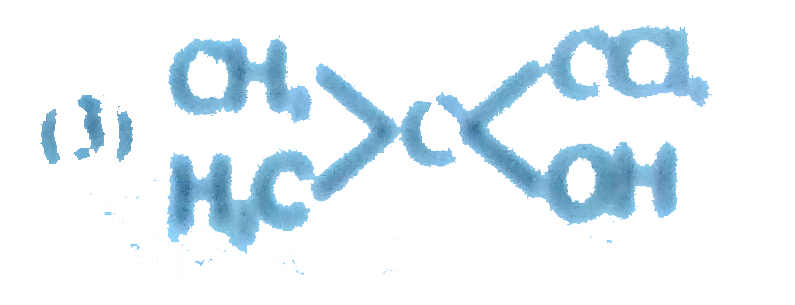Ph−C∣∣O−CH3NaOCl−−−→A+salt
A+CH3−C∣∣O−CH3→B'B' is
CH3−C∣∣O−CH=C∣CH3−Ph
Ph−C∣∣O−CH=CH−C∣∣O−CH3

CH3−Cl∣C∣Cl−CH3
The correct Answer is:C
To solve the question step by step, we will analyze the reactions provided and identify the products formed.
Step 1: Identify the first reaction
The first reaction involves the compound CH₃C(=O)CH (which is an aldehyde) reacting with sodium hypochlorite (NaOCl). This is known as a chloroform reaction.
Hint: Look for the type of reaction taking place and the reagents involved.
Step 2: Write the reaction and identify the products
In this reaction, the compound CH₃C(=O)CH reacts with NaOCl, leading to the formation of chloroform (CHCl₃) and a sodium salt. The salt formed is CH₃C(=O)O⁻Na⁺.
Hint: Focus on the products of the chloroform reaction, which typically produces chloroform and a salt.
Step 3: Identify product A
From the first reaction, we conclude that product A is chloroform (CHCl₃) and the salt formed is sodium acetate (CH₃C(=O)O⁻Na⁺).
Hint: Remember that in chloroform reactions, chloroform is a common product.
Step 4: Identify the second reaction
Next, we analyze the second reaction where product A (CHCl₃) reacts with another compound, which is CH₃C(=O)CH₃ (acetone).
Hint: Identify the reactants in the second reaction and their structures.
Step 5: Write the reaction for the second step
In this reaction, chloroform (CHCl₃) reacts with acetone (CH₃C(=O)CH₃). The mechanism involves the nucleophilic attack of the acetone on the electrophilic carbon of chloroform.
Hint: Consider the mechanism of nucleophilic substitution where acetone acts as a nucleophile.
Step 6: Identify product B
The product formed from this reaction is known as chloritone (also referred to as fluoritone). The structure of chloritone is CH₃C(=CCl)CH₃.
Hint: Look for the final product structure and confirm it matches the expected product.
Conclusion
Thus, the final product B is chloritone (fluoritone), which corresponds to the options given in the question.
Final Answer: The product B' is chloritone (fluoritone).
The first reaction involves the compound CH₃C(=O)CH (which is an aldehyde) reacting with sodium hypochlorite (NaOCl). This is known as a chloroform reaction.
In this reaction, the compound CH₃C(=O)CH reacts with NaOCl, leading to the formation of chloroform (CHCl₃) and a sodium salt. The salt formed is CH₃C(=O)O⁻Na⁺.
From the first reaction, we conclude that product A is chloroform (CHCl₃) and the salt formed is sodium acetate (CH₃C(=O)O⁻Na⁺).
Next, we analyze the second reaction where product A (CHCl₃) reacts with another compound, which is CH₃C(=O)CH₃ (acetone).
In this reaction, chloroform (CHCl₃) reacts with acetone (CH₃C(=O)CH₃). The mechanism involves the nucleophilic attack of the acetone on the electrophilic carbon of chloroform.
The product formed from this reaction is known as chloritone (also referred to as fluoritone). The structure of chloritone is CH₃C(=CCl)CH₃.
Thus, the final product B is chloritone (fluoritone), which corresponds to the options given in the question.
Topper's Solved these Questions
Similar Questions
Knowledge Check
In the following reaction sequence,
CH3−C∣OH(X)H−CH3[O]−−→YCH3MgBr−−−−−−−−→H+/H2OZ
Z isAbutan-1-olBbutan-2-olC2-methylpropan-2-olD1,1 - dimethylethanol.
name the following reactions(i). R−CH∣OH−CH2COOHNaHCO3−−−−−→ΔR−CH∣OH−CH2−H
(ii). R−CH∣NO3−CH2COOHNaHCO3−−−−−→ΔR−CH∣NO3−CH2−H
(iii) R−C∣∣O−CH2COOHΔ−−→R−C∣∣O−CH3
View SolutionI. CH3−CH2−CH2−CH2−OH
II. CH3−CH2−CH∣OH−CH3
III. CH3−CH3∣C∣OH−CH3
IV. CH3−CH∣CH3−CH2−OH
V. CH3−CH2−O−CH2−CH3
VI. CH3−O−CH2−CH2−CH3
VII. CH3−O−CH∣CH3−CH3
Identify the pairs of compounds that represents position isomerism.
View SolutionI. CH3−CH2−CH2−CH2−OH
II. CH3−CH2−CH∣OH−CH3
III. CH3−CH3∣C∣OH−CH3
IV. CH3−CH∣CH3−CH2−OH
V. CH3−CH2−O−CH2−CH3
VI. CH3−O−CH2−CH2−CH3
VII. CH3−O−CH∣CH3−CH3
Identify the pairs of compounds which are functional group isomers
View SolutionI. CH3−CH2−CH2−CH2−OH
II. CH3−CH2−CH∣OH−CH3
III. CH3−CH3∣C∣OH−CH3
IV. CH3−CH∣CH3−CH2−OH
V. CH3−CH2−O−CH2−CH3
VI. CH3−O−CH2−CH2−CH3
VII. CH3−O−CH∣CH3−CH3
Which of the above compounds form pairs of metamers ?
View SolutionI. CH3−CH2−CH2−CH2−OH
II. CH3−CH2−CH∣OH−CH3
III. CH3−CH3∣C∣OH−CH3
IV. CH3−CH∣CH3−CH2−OH
V. CH3−CH2−O−CH2−CH3
VI. CH3−O−CH2−CH2−CH3
VII. CH3−O−CH∣CH3−CH3
Identify the pair of compounds that represents chain isomerism
View SolutionFind out no of compounds that gives positive iodoform test (either in cold or hot condition)
(A) H3C−C∣∣O−CH2−CH3
(B) I3C−C∣∣O−CH2−CH3
(C) CH3−C∣OH−CH2CH3
(D) CH2l−CH∣OH−CH2CH3
(E) CH3CH2OH
View SolutionConsider the following reactions
I.
II.(CH3)2C∣OH−CH2−CHOΔ−−→
III. (CH3)2CHCH2−C∣FH−CH3CH3O−Na+−−−−−−−−−−→Δ
IV. (CH3)2CH−C∣BrH−CH3(CH3)3CO−k+−−−−−−−−−−→
Which of these reaction will not produce Hoffmann product?
View Solution
